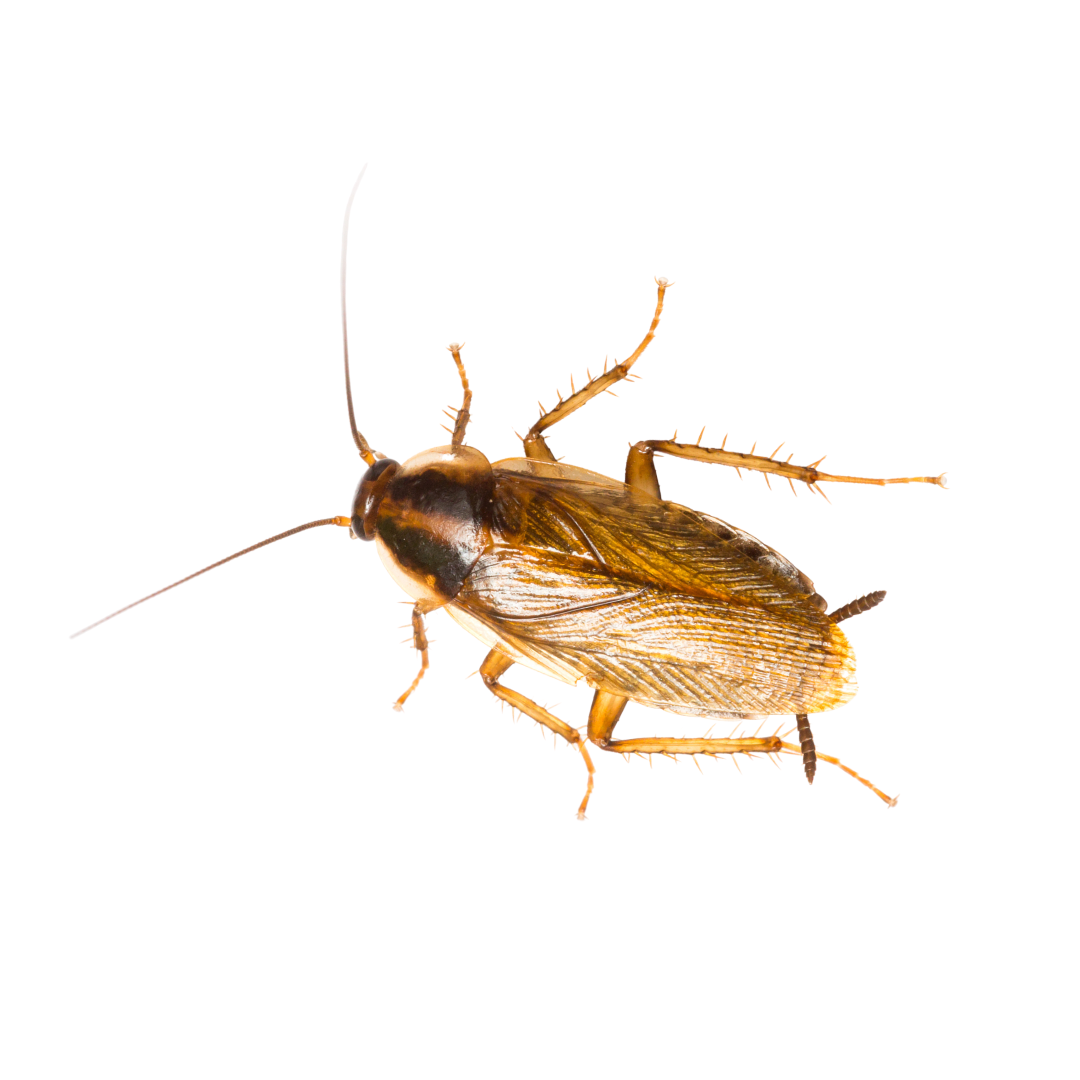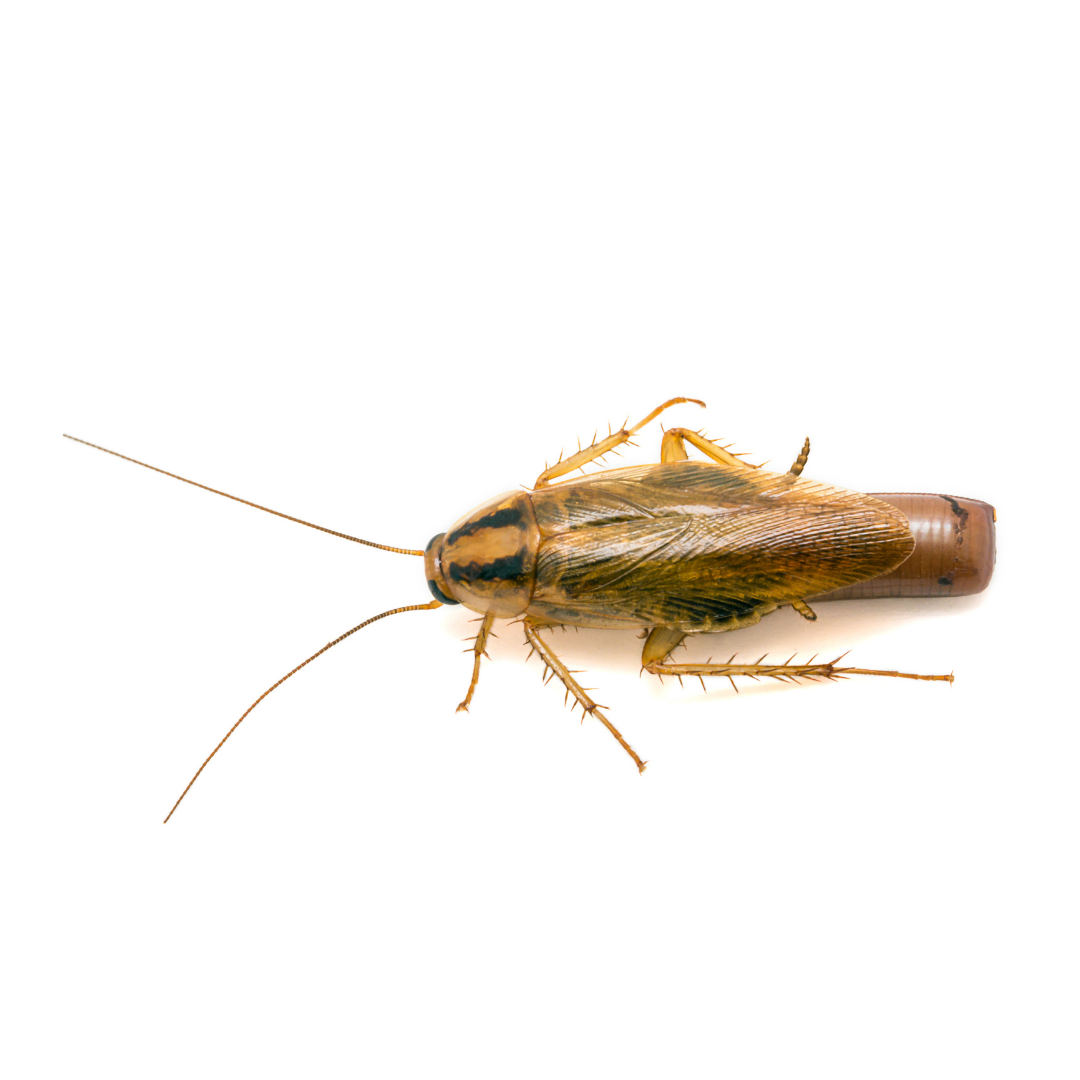German Cockroach (Blattella germanica)


German Cockroach Description
Adults: Adults are 15 mm (0.625 inches) long. Light brown in color with two prominent black stripes running down the broad shield (pronotum) behind the head.
Eggs: Eggs are contained inside a capsule-like structure, made by the females, called an ootheca. Females carry the ootheca until it is within 1 to 2 days of hatching, and then deposit it in a protected location. A female may produce 4 to 8 ootheca in her lifetime with average 30 - 40 eggs per ootheca.
Larvae: Cockroaches undergo incomplete metamorphosis and do not have a larval stage. Young cockroaches are referred to as nymphs. Newly hatched nymphs range in color from cream/tan to black/brown and tend to resemble the adults more closely as they reach maturity.
Pupae: There are no pupae in the German cockroach life cycle due to incomplete metamorphosis.
German Cockroach Life Cycle
Developmental time from egg to adult varies from 54 days to 215 days depending upon temperature and humidity., Generally, it takes 50 to 60 days for an egg to develop into an adult. Adults live 100 to 200 days.
Damage & Detection
Warm and humid areas are preferred but infestations can occur in many structural areas. Kitchens, locker rooms, and bathrooms are the most infested areas. The insects themselves are often visible in infested areas as well as fecal spots in and near harborage areas.
Fun Facts
Similar species include American cockroach (Periplaneta americana), oriental cockroach (Blatta orientalis), smokey brown cockroach (Periplaneta fuliginosa), and brown-banded cockroach (Supella longipalpa).
Spread filth and germs from unsanitary places like sewers, garbage, damp areas onto food supplies and food prep surfaces.
Can carry a wide variety of protozoa and other microorganisms which may occasionally spread disease to humans.
Excrement and cast skins can cause allergic reactions.
Usually not associated with severe illnesses or disease outbreaks.
Monitoring Tips & Tricks
Cockroach & Silverfish Lure - Contains food attractant odors for multiple pest species.
Lure Storage
Keep unopened lures in cool storage less than 16°C (60°F) or place in the freezer for extended storage. Lures can remain frozen for up to 24 months or at room temperature for 12 months to retain their full effectiveness for use afterwards
Trap Designs Used with Lure
Flat traps that sit horizontally on the floor or a shelf and that have less than a 2 mm rise or ones that incorporate a shallow ramp that leads into a sticky glue are recommended to use with the Cockroach & Silverfish Lure. The lure should be placed in the very center of the glue surface.
Trap Placement & Use
Trap Placement Techniques
Food lure traps can be out placed year-round but are especially recommended during warmer months when temperatures exceed 12.5°C (55°F). Floor traps like the Flat Trap are most effective at capturing German cockroaches. In areas such as a closet or home, place one or two traps per room.
In commercial areas, such as warehouses or retail stores, place food lure traps 7.5–15 m (25–50 feet) apart to determine the presence or absence of German cockroaches. Increase food lure trap density to 4.5–7.5 m (15–25 feet) apart to help locate the source of German cockroaches.
German cockroach food lure traps are best utilized in areas that store food goods, particularly items that contain meats, starches, sugars, and fatty foods.
Trap and Lure Maintenance
Replace traps when glue is filled with insects or becomes dusty. Replace pheromone lures every 90 days. Replace all pheromone lures in a location at the same time. Do not stagger lure replacement over several weeks. Record date and number of catches to identify trending information.
Pest FAQs
What is the German cockroach life cycle?
Developmental time from egg to adult of the German cockroach varies from 54 days to 215 days depending upon temperature and humidity. Generally, it takes 50 to 60 days for an egg to develop into an adult.
Adults live 100 to 200 days. German cockroach eggs come in cases of 35-50 eggs all within the same case. These cases are carried by the female for 15 days or more, right up until the point that they are about to hatch, and are then dropped into secluded spaces to hatch.
What causes a German cockroach infestation?
German cockroaches did not actually originate in Germany. Their origins were tropical areas in southeast Asia. Because of this, German cockroaches like warm and humid temperatures (think tropical) with lots of food availability.
This is why they like to be in the warm areas around the motors of refrigerators, inside the working parts of microwave ovens, in the back of CD players, etc. These areas also are the most likely places where we leave food crumbs or leftover snacks after watching a video. Given the right temperature, humidity and food, the numbers of German cockroaches in a home can rise at an exponential rate until the German cockroach infestation becomes very difficult to manage.
The nymphs that have just hatched out of the eggs are flat bodied and only 1/8 of an inch (3 mm) long. They can hide in really small spaces.
How do I get rid of German cockroaches?
To get rid of German cockroaches, you first must figure out where they are living and breeding. This can be done with monitoring traps. Increased sanitation through the means of removing their food sources is essential in getting control of this pest.
Pest management professionals can assist with finding the correct mix of sanitation, trapping, cockroach baits or registered pesticides that can help eliminate German cockroaches.
Join Our Informed Community
Receive the latest industry updates as soon as they are published.



